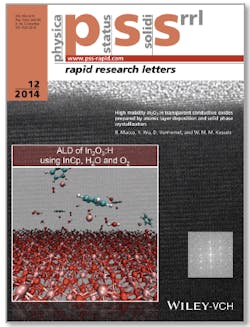Solar cells to benefit from improved indium oxide deposition quality
Eindhoven University of Technology (TU/e) researchers have developed a novel approach to prepare transparent conductive oxides (TCOs) consisting of hydrogen-doped indium oxide (In2O3:H) that are both highly conductive and highly transparent. Using an Oxford Instruments Atomic Layer Deposition (ALD) system, the team was able to prepare amorphous In2O3:H at 100 °C by ALD, followed by a brief solid phase crystallization step at 200 °C. In comparison to conventional sputtered tin-doped indium tin oxide (ITO), the salient feature of the ALD In2O3:H process is the superior electron mobility that simultaneously enables a lower resistivity (0.26 mΩ cm) and a negligible free carrier absorption in the infrared.
Related Article
Oxford Instruments says its FlexAL and OpAL tools allow both the deposition of the amorphous indium oxide as well as the subsequent crystallization at modest temperatures of 150 to 200 °C. The high conductivity and high transparency, in conjunction with the low-temperature, soft processing, makes the method especially promising for the application of the TCO in silicon heterojunction solar cells.
"Prof. Kessels and the Plasma and Materials Processing (PMP) group at TU/e continue to conduct exciting research using our ALD systems within new application areas," said Oxford Instruments Plasma Technology's ALD product manager, Chris Hodson. "This key technology advance is of real interest to the solar cell research community, and I’m certain our continuing collaboration with TU/e will bring additional advances in this and other technology areas."
Kessels says, "There is still a lot of potential for improving solar cells by thin films prepared by ALD, it is a very versatile technique yielding the highest quality films at low temperatures, without inducing damage, and with an unparalleled level of growth control. These are merits yielding opportunities for virtually all types of solar cells."
SOURCE: Oxford Instruments; http://www.oxford-instruments.com/news/2015/april/breakthrough-in-indium-oxide-quality
About the Author

Gail Overton
Senior Editor (2004-2020)
Gail has more than 30 years of engineering, marketing, product management, and editorial experience in the photonics and optical communications industry. Before joining the staff at Laser Focus World in 2004, she held many product management and product marketing roles in the fiber-optics industry, most notably at Hughes (El Segundo, CA), GTE Labs (Waltham, MA), Corning (Corning, NY), Photon Kinetics (Beaverton, OR), and Newport Corporation (Irvine, CA). During her marketing career, Gail published articles in WDM Solutions and Sensors magazine and traveled internationally to conduct product and sales training. Gail received her BS degree in physics, with an emphasis in optics, from San Diego State University in San Diego, CA in May 1986.

